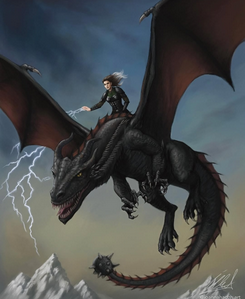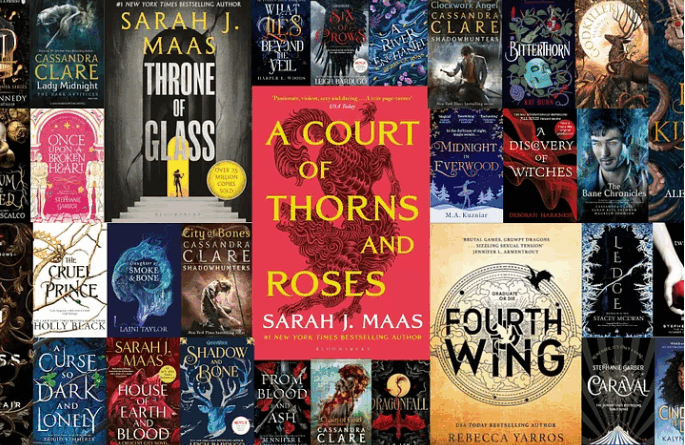Romantasy Genre: Feminism, Fantasy, and the Rise of Power
A genre known as Romantasy, which combines both fantasy and romance, has surged in popularity since the COVID-19 pandemic, as people were relegated to stay at home and tried to seek new forms of escape. While this genre feels new, its roots stretch back several decades. One of the earliest examples being War for the Oaks by Emma Bull, published back in 1987. This story surrounds the tale of a female rock singer being drafted into a faerie war, and during this unexpected adventure, she falls for the very being who first put her in this new danger. Today, Romantasy has taken off once more thanks to the help of BookTok – a community on TikTok where users recommend, review, and celebrate books. Viral hits such as bestsellers like Sarah J. Maas’s A Court of Thorns and Roses and Rebecca Yarros’s Fourth Wing have vaulted to the top of some of the most prevalent bestseller lists.
This genre seems to have captivated a mainly female audience with tales of lands filled with fantasy, fated love, and heroines who rise from the ashes. However, beneath the want to ride dragons and the call of fleeing to fantasy courts lies something more palpable. This is a genre that speaks to emotional survival as well as escape. Romantasy gives women the space they need to examine the meaning of not only empowerment but trauma and healing within a lens that distorts boundaries of gender roles, romantic ideals, and traditional narratives. However, Romantasy works as not just an escape from their everyday lives but also as a genre that allows readers to reimagine their power and identity within a world like ours that still grapples with poisonous masculinity, emotional repression, and patriarchal norms of romance. As Jeremy Brown writes in an article named The Romantasy era, “Romantasy isn’t just entertainment-it’s a rebellion wrapped in velvet, a genre that reclaims softness, vulnerability, and desire as sources of strength in a world that often punishes them.”
Even though it seems as though women are the intended target for this genre, a growing number of men appear to be engaging with it as well, whether with enthusiasm or sometimes annoyance. While some male readers seem to enjoy the elaborate worldbuilding involved, along with the complexities of the world dynamics, they seem to balk at emotional vulnerability and the romantic themes that fill these stories. This inner tension they feel reflects on how gender norms in society are set in a way that assumes that emotional expression can only be feminine and that men shouldn’t be vulnerable. As CultureSlate states, “to the manosphere, romantasy is an existential threat: a genre that dares to prioritize female pleasure, emotional complexity, and soft power in realms traditionally ruled by grit and stoicism.” In this context, the genre itself becomes a cultural phenomenon, pushing back against the rigid notions of masculinity and who gets to be in the center of the story. Instead of rejecting these adjustments immediately, some men are beginning to see these tales of Romantasy as a means of rethinking their own beliefs on emotions, identity, and belonging.
Fantasy fiction has always featured an area of imaginative possibility, where readers can imagine other worlds and new versions of who they wish to be. And in these stories, there are often mirror images of similar world hierarchies; however, women are given the power to not only fight back but to challenge them further. There are no more gender rules about who is in charge, who should be saved, and what the characters should feel. Max Fletcher, from The Guardian, writes in his article discussing the inner workings of novels such as ACOTAR and Fourth Wing, writing that, “part of the genre’s appeal is its reversal of gender roles.” Instead of being led by a man, the female main characters are the ones who learn the systems in place, and fight back, whether it be with emotion, daggers, or their minds. Romantasy doesn’t skirt past hurt and pain; it takes that pain and turns it into growth and strength.
That aforementioned growth is seen throughout the story in the protagonists who, while they begin their journey weak, tend to gain their influence through multiple hardships and losses, which toughen them and lead them toward the personal growth needed to overcome their challenges. These attributes can be witnessed in characters such as Feyre Archeron in A Court of Thorns and Roses and Violet Sorrengail in Fourth Wing. Feyre, who begins life as a human hunter, endures poverty and abuse from her family in the beginning until she is taken from them and brought to a new world, soon working through her trauma enough to learn to protect the people she loves. Violet is shown to be a weak and brittle girl who strives for knowledge but, at her mother’s hand, is forced into a harsh dragon-riding military academy where survival is uncertain, and trauma is promised, eventually proving herself to be an invaluable force of nature. Their magical powers and physical capabilities grow as they heal emotionally, which leads to the idea that true strength can come in the form of vulnerability.


Violet Sorengail with Tairn Feyre Archeron v. Middengard Wyrm
Romantic partners in these novels tend to feature relationships as places filled with mutual respect, consent, and emotional openness. Rhysand and Feyre’s relationship shows one of partnership and healing, creating an alternative choice to the negative and controlling relationship she once had. Likewise, Violet and Xaden’s slow-burning trope in Fourth Wing is established on communication, trust, and boundaries, characteristics that can be difficult to find when looking for a romantic partner in the real world. These relationships are especially powerful because they reframe emotional intimacy as a strength. In Romantasy, this desire is often legitimized and turned into a magical destiny through mated bonds, vows, or shared trauma. While the genre sometimes stands on the edge of romanticizing possession or dominance, particularly in alpha male characters, its central relationships instead tend to uphold respect over ownership, creating a new model for love founded on emotional safety.
Romantasy has also started to jump off the pages and into the hearts and communities of the readers. On BookTok, influencers weep over moments of sadness, marvel at the strength of female heroines, and debate the morality of love interests with passion from the books that are trending. These fandoms don’t just read stories, they live them, seeing stories through the lens of fan art, fan fiction, cosplay, and deep discussions. Fan studies scholar Paul Booth notes, “Fandom is the classroom of the future because people never stop learning, and their fandom is where that learning will happen.” For the majority of Romantasy readers, reading becomes a form of therapy. The emotional force of these novels now extends beyond the digital world of BookTok and fan clubs and into the real world, as Romantasy-themed fantasy balls, fandom-driven conventions, and cosplay competitions take place worldwide. Fans cosplay as their favorite assassin, fae-warrior, and dragon riders, celebrating their strength and femininity as a form of self-expression and confidence. These events show the power within these novels.
It should be mentioned that while Romantasy offers up empowering tales, there is a dark, twisted side that exists in the subgenre of Dark Romance, where stories focus on tropes filled with violence, domination, and morally gray love interests getting pushed to the extreme. In most of these books, danger is seen as a turn-on, and the boundaries of consent and control are purposely smeared. Additionally, this genre offers the potential to engage with these same complex, even transgressive desires within a safe space, sometimes featuring mythical creatures such as werewolves, vampires, and other “monsters.” This does, however, glamorize and romanticize dangerous behaviors like stalking, manipulation, and even coercive sex, which can create harmful narratives for its audience. It is best read by those who are above the age of eighteen, and it is important to read the trigger warnings before reading anything within this genre.
The Romantasy genre, for all its faults, is more than just a passing trend; it’s a cultural phenomenon that isn’t giving up any time soon. In these worlds of fantasy that are populated with dragons, fae, and warriors, women are finding themselves lost in the space to feel, to fight, and to heal themselves. These books allow people to feel emotional without shame, love without submission, and power without having to apologize. These stories respond to a world that asks too much of women and gives too little in return, offering us a way to imagine a different life. While Romantasy still holds remnants of systems it is working to redefine, it offers an intriguing fantasy: that pain can create a purpose, and that delicacy might grow even in the harshest of worlds.

